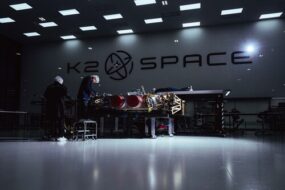Argo Space Corporation raised $7.9M from investors to build water-fueled space tugs as a first step toward its long-term goal of using water from the Moon to fuel a space transportation ecosystem.
The financing, led by Crosslink Capital and including Stellar Ventures and Type One Ventures, comes after a $2 million pre-seed round in April and $2M in SBIR funding; the company is staffing up to build the first Argonaut demonstration vehicle, expected to launch in 2025.
“We did start on the resources side, and thought, that’s cool and interesting in a scientific way, but there’s no demand,” CEO Robert Carlisle told Payload. “So how do we build a future where there is? We came back to what is a real commercial use case to deploy lunar resources.”
All wet. Argo’s immediate business—delivering small satellites to bespoke orbits after launching to LEO—is reminiscent of Momentus, the company whose water-fueled space tug never quite met expectations; the firm is now facing delisting by the NASDAQ stock exchange.
Argo is developing a larger reusable and refuelable vehicle capable of carrying ESPA-class payloads up to 1000 kg, and its own high impulse plasma thruster. Combined with in-space refueling, Carlisle expects Argonauts to win customers looking for low-cost access to unusual orbits.
The benefits of water as fuel is that it is cheap, available, and safe to handle; the challenges include preventing it from freezing in orbit, and lower thrust than other propellants.
If you build it. Argo’s long-term plan as a provider of “in-space transportation with in-space propellant” is to get its fuel from the Moon, and the co-founders—three brothers who all previously worked at SpaceX—say they have designed a system to harvest water from lunar regolith.
Water-fueled orbital transfer vehicles linked to propellant depots on the Moon could make in-space refueling a normal part of satellite operations. In 2022, ULA chief Tory Bruno proposed government-funded lunar propellant depots as a way to realize that vision.
Moon rush. Argo isn’t the only company with lunar resources top of mind. In the last year, we’ve seen…
- Interlune, led by former Blue Origin engineer Gary Lai, announced a $15.6M raise in January, with the company focusing on extracting He-3 from the regolith.
- Ethos, a company led by SpaceX veterans with plans to build landing pads and extract LOX from the regolith, emerged from stealth in June.
- Starpath, founded by (you guessed it) SpaceX alums, announced a $12M seed round for its power station and fleet of ice-harvesting robots in August.
And that doesn’t include Moon-focused companies like ispace, which will attempt to split lunar water with its next lander, or Intuitive Machines, which will send a water-hunting drill to the lunar surface in its fourth mission.




